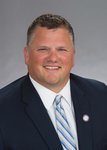


On Tuesday, Jan. 24, Gov. Kim Reynolds signed the Students First Act into law at the Iowa State Capitol building in Des Moines.
The bill had passed the Iowa House the day before with a 55-45 vote, and the Iowa Senate passed the bill that Tuesday morning in a 31-18 vote.
The main argument for the bill has been to support the idea of school choice, which has become a central focus of Reynolds’ tenure as governor in recent years. The newly signed bill will use taxpayer dollars and public funding to create education savings accounts (ESAs) for students and families that choose to attend private schools.
“For the first time, we will fund students not systems,” Reynolds posted on Twitter. “Parents, not the government, can now choose the education setting best suited to their child regardless of their income or zip code. Iowa has affirmed that educational freedom belongs to all!”
Once fully implemented in its fourth year, the measure will cost $344.9 million per year, and the funds for each ESA are projected to be just under $7,600 per student, which can be used for “tuition, fees, and other qualified education expenses.” The following description of the bill’s implementation is quoted verbatim from a press release sent out by the Governor’s Office.
“During the 2023-2024 school year, private school students with household incomes at or below 300% of the federal poverty level (FPL), currently $83,250 for a family of four, are eligible. In the 2024-2025 school year, private school eligibility expands to include families with household incomes at or below 400% FPL, currently $111,000 for a family of four, are eligible. Beginning in the 2025-2026 school year, all K-12 students in Iowa are eligible regardless of family income.”
All incoming kindergarteners and current public school students will be eligible in year one of the plan. The state will provide $1,200 in funding to public schools for each student a public school loses to private schooling.
A third-party to oversee the ESAs is currently being searched for by the state. According to the press release from the Governor’s Office, “the vendor selected will manage the application process, support the transfer of funds from the state to ESA accounts of eligible students, and ensure program compliance.” The cost of paying a business to oversee the program could affect its overall cost.
The application period will begin once that third-party vendor is selected, and applications will be accepted through June 30, 2023.
Christi Gochenour, superintendent of the Missouri Valley Community School District, raised concerns about the bill, which she noted was passed without going through appropriations, ways and means, and without forecasting for the future.
“I am not against school choice,” Gochenour said. “Parents should have a right to send their children to the school that is the best fit for their child, and we currently have this option through Open Enrollment. Where I struggle is that, when public money goes to a private school it is no longer public money. There is not the same oversight. Private schools do not have publicly voted boards that represent the general community and they do not have to report how that money is spent. Public schools have elected community officials that ensure transparent financial accountability. At this time there is no language in the bill that would require the same accountability for private schools.”
Boyer Valley Superintendent Jeremy Christiansen shared a similar sentiment.
“It is disappointing that we are at this point in education,” he said in an email to the Times-News and Reporter. “Now that it has passed we have to think differently on how we move forward in some areas to continue to serve our students at the highest level possible.”
Christiansen also predicts that there will be a “bump in the road” with state funding for education down the road, and that the school district will be stuck in a wait-and-see phase due to the uncertainty surrounding the bill’s impact.
According to Christiansen, many parents and teachers have also shared their thoughts on the bill with him.
“I have not had one person in our district excited about this that I have met with up to this point,” he said.
As far as the “students not systems” argument proponents of the bill use, Gochenour takes issue with what she believes is not an “apples to apples” approach, but rather apples to oranges.
“They say this is no longer about feeding the system but instead feeding the kids,” Gochenour said. “I agree. But they tie our hands with what we can and can’t do in public schools. They don’t tie private schools. If a private school has a behavioral problem with a student, they can choose to remove the student from their system. As a public school, we get to continue work with the student and the family to help the student develop, and I mean ‘get’. Not ‘we have to’. We get to. We get to educate every child that walks through our door.
If we have a child come to Missouri Valley Schools and we do not have an educational program that fits his or her needs, we create it or we pay to have that child attend a school with a program that meets the needs. Private schools may choose to not accept the student. To me this is not equal. Creating these programs to meet all students' needs is expensive and when this expense happens during the school year, it is not budgeted, which means other areas may need to be cut.”
Tom Ridder, superintendent of the Logan-Magnolia School District, argued a similar point.
“As a public school we have to follow certain standards,” he said. “We can not pick and choose which students we allow in our schools. Will there be the same restrictions on private schools that they have on us? If we have a student causing problems in school, we have to deal with them, and we should as a public school. Are private schools gonna have to follow the same procedures we do? Or will they be allowed to expel students just because they misbehaved?”
Ridder also expressed concerns with the burden taxpayers in the area will now have despite the closest private school being in Council Bluffs.
“The biggest issue for me is that our taxpayers will be paying for private schools in other parts of the state,” he said.
Ridder anticipates the effects on the Logan-Magnolia community won't show at first, but may start to once the bill is in full effect a few years from now.
Gochenour reached out to State Senator Mark Costello and Rep. Matt Windschitl, who represents the 17th district and is the Majority Leader of the House. She says she did not hear back from Costello until late last week after the vote. He stated in his email that he would reach out when he was back in the area. When she asked Windschitl how many of his constituents told him they want public funds directed toward private schools, he told her she would be amazed at how many, but did not give a firm number.
“The response I’ve heard from our representatives and reading what the governor has written is public schools need to improve what we do,” she continued. “I feel that we are improving our practices all the time despite the budget constraints.I feel like what we do is phenomenal. The Governor and our legislatures say we need to increase the pay for our teachers. I’d love to increase the pay for my teachers, but the Governor requested only a 2.5% increase in state money, which for Missouri Valley Community School District is $67,000.
How do we give teachers, paras, cooks, bus drivers, custodians, secretaries, and administration adequate raises? It’s not possible to pay our staff what they’re worth with only a 2.5% raise from the state. Putting $341 million per year into public schools would go a long way to raising educational staff salaries as well as continued funding for educational programs across the state of Iowa.”
Gochenour also pointed out that Gov. Reynolds and the legislature have talked about spending 43% of the state's general fund towards education, which is higher than 41% last year. The general fund balance is less this year than it was last year, so the percentage is higher despite the actual amount of money coming in being lower.
But, the bill has passed, and an eye will be kept towards the future as public school systems around the state attempt to navigate the potential changes that will be coming their way.
“Moving forward immediately we must start to push for other items that could help public schools manage the uncertainty,” Christiansen said.